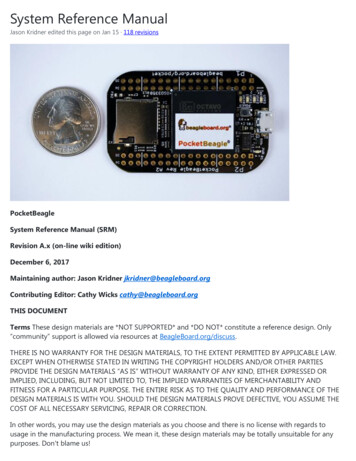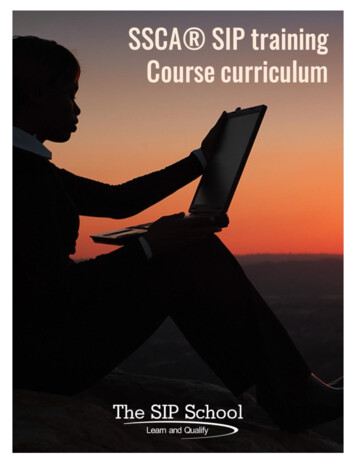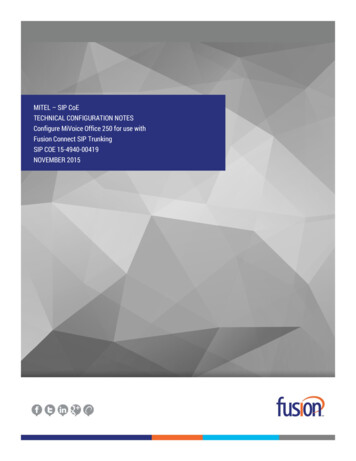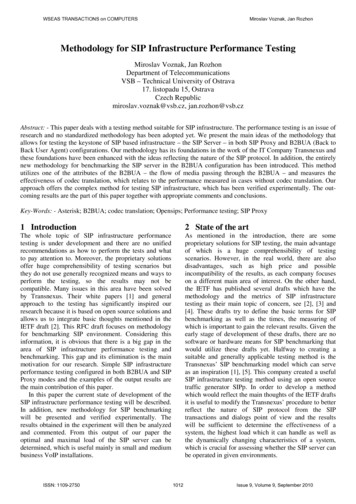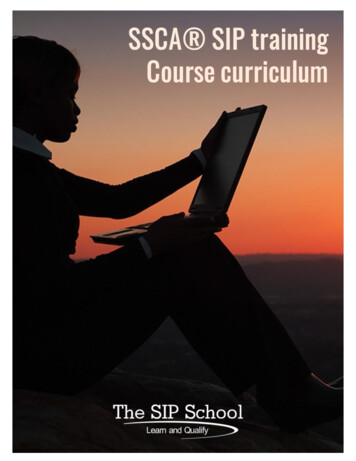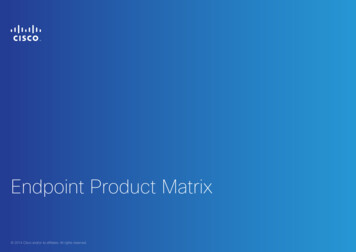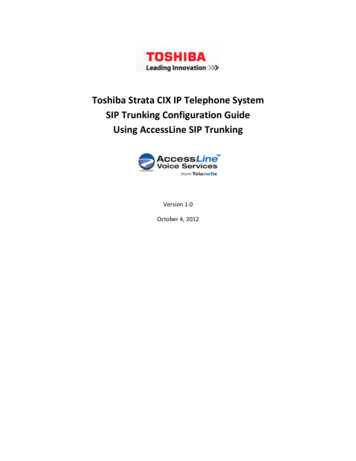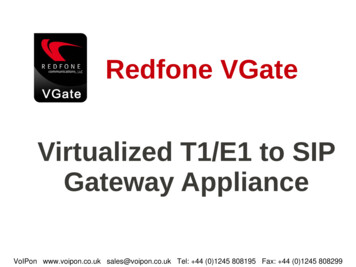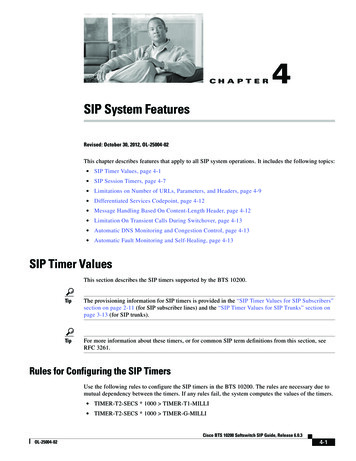
Transcription
CH A P T E R4SIP System FeaturesRevised: October 30, 2012, OL-25004-02This chapter describes features that apply to all SIP system operations. It includes the following topics: SIP Timer Values, page 4-1 SIP Session Timers, page 4-7 Limitations on Number of URLs, Parameters, and Headers, page 4-9 Differentiated Services Codepoint, page 4-12 Message Handling Based On Content-Length Header, page 4-12 Limitation On Transient Calls During Switchover, page 4-13 Automatic DNS Monitoring and Congestion Control, page 4-13 Automatic Fault Monitoring and Self-Healing, page 4-13SIP Timer ValuesThis section describes the SIP timers supported by the BTS 10200.TipThe provisioning information for SIP timers is provided in the “SIP Timer Values for SIP Subscribers”section on page 2-11 (for SIP subscriber lines) and the “SIP Timer Values for SIP Trunks” section onpage 3-13 (for SIP trunks).TipFor more information about these timers, or for common SIP term definitions from this section, seeRFC 3261.Rules for Configuring the SIP TimersUse the following rules to configure the SIP timers in the BTS 10200. The rules are necessary due tomutual dependency between the timers. If any rules fail, the system computes the values of the timers. TIMER-T2-SECS * 1000 TIMER-T1-MILLI TIMER-T2-SECS * 1000 TIMER-G-MILLICisco BTS 10200 Softswitch SIP Guide, Release 6.0.3OL-25004-024-1
Chapter 4SIP System FeaturesSIP Timer Values TIMER-B-SECS * 1000 TIMER-A-MILLI TIMER-F-SECS * 1000 TIMER-E-MILLI TIMER-D-SECS 32In addition to these rules, the timer values must be in the range of values specified in the “DetailedDescription of Timers” section.Detailed Description of TimersThe following list describers the timer parameters in the SIP Timer Profile (sip-timer-profile) table. TIMER-T1-MILLI (range 100–5000, default 500, in milliseconds)—T1 is an estimate of theround-trip time (RTT). The system uses this timer to calculate the default values of the transactiontimers A through H and J in the following list. Many of those timers scale with T1; therefore,changing the T1 value changes the default values for timers A through H and J. The calculation isshown in the “Computation of Default Timer Values A Through J from Timers T1 and T4” sectionon page 4-5. TIMER-T2-SECS (range 1–10, default 4, in seconds)—The maximum allowed interval fornon-INVITE requests. It is also used as the maximum retransmit interval for SIP INVITE responses. TIMER-T4-SECS (range 1–10, default 5, in seconds)—The timer represents the maximum amountof time the network takes to clear messages between client and server transactions. The system usesthis timer to calculate the default value of the transaction timer TIMER-I-SECS; therefore, changingthe T4 value changes the default value for TIMER-I-SECS. The calculation is shown in the“Computation of Default Timer Values A Through J from Timers T1 and T4” section on page 4-5. TIMER-A-MILLI (range 100–5000, default 0, in milliseconds)—The UAC timer for INVITErequest retransmit interval. For example, if the value is 500 ms, the INVITE request retransmissionsocc2 seconds). Applicable to UDP only. If TIMER-A-MILLI is set to the default value of 0, thesystem automatically calculates a value for it, as shown in the “Computation of Default TimerValues A Through J from Timers T1 and T4” section on page 4-5. TIMER-B-SECS (range 1–3600, default 0, in seconds)—The UAC INVITE transaction timer limitsthe INVITE transaction timeout. For SIP TCP trunk connections, there are certain scenarios inwhich the BTS 10200 does not immediately detect a loss of connection to an IP address endpointafter transmitting an INVITE request. As a result, we recommend provisioning this timer to 6seconds when you are configuring TCP trunks, so that advancing to the FQDN’s next IP addressoccurs in a timely manner. If TIMER-B-SECS is set to the default value of 0, the systemautomatically calculates a value for it, as shown in the “Computation of Default Timer Values AThrough J from Timers T1 and T4” section on page 4-5. TIMER-D-SECS (range 33–65, default 33, in seconds, set to 0 for TCP)—The user agent client(UAC) timer used for the wait time of response retransmissions. For INVITE, because an ACK couldbe lost, the user agent server (UAS) must wait at least 32 seconds (assuming the default transactiontimer on the other end is 32 seconds) to receive any retransmissions of responses from the UAS andsend an ACK. In a Cisco BTS 10200 implementation, this transaction clearing timer is applicableonly for INVITE requests. For non-INVITE messages, the transaction is cleared immediately uponreceipt of final response. If TIMER-D-SECS is set to the default value of 0, the system automaticallycalculates a value for it, as shown in the “Computation of Default Timer Values A Through J fromTimers T1 and T4” section on page 4-5. TIMER-E-MILLI (range 100–5000, default 0, in milliseconds)—The UAC timer for a non-INVITErequest retransmit interval. For example, if the value is 500 ms, the non-INVITE requestretransmissions occur at intervals of 500 ms, 1s, 2s, 4s, 4s, 4s, 4s, 4s, 4s, and 4s (assumingTIMER-F-SECS defined below is 32 seconds and TIMER-T2-SECS defined previously is fourCisco BTS 10200 Softswitch SIP Guide, Release 6.0.34-2OL-25004-02
Chapter 4SIP System FeaturesSIP Timer Valuesseconds). This parameter is applicable to user datagram protocol (UDP) only. If TIMER-E-MILLIis set to the default value of 0, the system automatically calculates a value for it, as shown in the“Computation of Default Timer Values A Through J from Timers T1 and T4” section on page 4-5. TIMER-F-SECS (range 1–3600, default 0, in seconds)—The UAC non-INVITE transaction timerthat limits the number of retransmissions for non-INVITE requests. If TIMER-F-SECS is set to thedefault value of 0, the system automatically calculates a value for it, as shown in the “Computationof Default Timer Values A Through J from Timers T1 and T4” section on page 4-5. TIMER-G-MILLI (range 100–5000, default 0, in milliseconds)—Specifies the INVITE responseretransmit interval. The UAS timer implemented to achieve reliability of successful final responsesto INVITE requests. It starts when you are using a reliable transport protocol such as TCP. Eventhough the transport protocol might be reliable up to the next hop, it is not guaranteed reliableend-to-end if there are several proxy servers along the path when the call is set up. This timer isstarted when a a final response is sent for an INVITE request. The timer stops when a matching ACKis received for the final response sent. For example, if a 200 OK is sent for INVITE, the UAS mustreceive the matching ACK for the 200 OK. If the TIMER-G-MILLI is 500 ms, the final response tothe INVITE from the UAS retransmits at intervals of 500 ms, 1s, 2s, 4s, 8s, 16s, 32s (assuming thatTIMER-H-SECS is 32 seconds). If TIMER-G-MILLI is set to the default value of 0, the systemautomatically calculates a value for it, as shown in the “Computation of Default Timer Values AThrough J from Timers T1 and T4” section on page 4-5. TIMER-H-SECS (range 1–3600, default 0, in seconds)—The UAS timer responsible for clearingan incomplete INVITE UAS transaction. It also controls the number of INVITE final responseretransmissions sent to UAC. The timer is started upon sending a final response for the INVITErequest. It is the total wait time for ACK receipt from UAC. If TIMER-H-SECS is set to the defaultvalue of 0, the system automatically calculates a value for it, as shown in the “Computation ofDefault Timer Values A Through J from Timers T1 and T4” section on page 4-5. TIMER-I-SECS (range 1–10, default 0, in seconds)—This UAS timer is the wait time for ACKretransmits. It frees the server transaction resources and starts when the first ACK to the finalresponse is received for INVITE requests. Upon receipt of an ACK for certain INVITE finalresponses (401, 415, 420, 422, 423, 480, and 484), the value of TIMER-I-SECS is set to a fixedduration of 32 seconds. The responses result in resubmission of the original INVITE withmodifications, and prevent the resources from prematurely freeing. A 481 (Call-Leg/Transactiondoes not exist) or a 408 (Request Timeout) response sent for the INVITE results in a much smallerfixed duration of four seconds for timer I. This ensures that CCB resources are promptly freed whenthe call is not set up, allowing reuse for other calls. For ACK to all other INVITE final responses,which are not typically followed by a re-attempt, the timer duration for this timer is set atTIMER-I-SECS.When a BYE is subsequently sent or received on a call in progress, and TIMER-I-SECS is runningfor that call, it is canceled and restarted for a smaller fixed duration of four seconds to reduce CCBhold time after call completion, and to optimize CCB resource usage.If TIMER-I-SECS is set to the default value of 0, the system automatically calculates a value for it,as shown in the “Computation of Default Timer Values A Through J from Timers T1 and T4” sectionon page 4-5. TIMER-J-SECS (range 1–3600, default 0, in seconds, set to 0 for TCP)—This UAS timer cleans upnon-INVITE UAS transactions. A shorter nonconfigurable timer of four seconds is used for BYEand CANCEL. Additionally, when a BYE or CANCEL is sent or received on a call in progress, ifTIMER-J-SECS is running for any non-INVITE transaction associated with that call, it is canceledand restarted for a smaller fixed duration of four seconds to reduce CCB hold time after callcompletion, and to optimize CCB resource usage. If TIMER-J-SECS is set to the default value of 0,the system automatically calculates a value for it, as shown in the “Computation of Default TimerValues A Through J from Timers T1 and T4” section on page 4-5.Cisco BTS 10200 Softswitch SIP Guide, Release 6.0.3OL-25004-024-3
Chapter 4SIP System FeaturesSIP Timer Values INVITE-INCOMPLETE-TIMER-SECS (range 15–600, default 40, in seconds)—This UAC timercleans up UAC INVITE transactions for which a provisional response less than 180 was received,but no ringing or final response was received within a reasonable period of time. This timer startsupon receipt of the first provisional response ( 100 and 180) for the INVITE message sent. Uponreceipt of the final response or 18x response to INVITE request, this timer is canceled.This timer is also started if a CANCEL is sent, to clean up the INVITE transaction in case of a finalresponse (487), indicating that the request was canceled, is not received.The process involving receipt of the 180 response is shown in Figure 4-1.Figure 4-1INVITE Incomplete Timer Process with 180 ResponseUABTSINVITE incomplete timeris started upon receipt1of first provisionalresponse 1802INVITE incomplete timeris canceled upon receiptof 180 Ringing.34INVITE transaction clearingtimer is started upon receiptof a final response.56INVITE sip:9725550122@UA;user phone SIP/2.0100 Trying180 Ringing200 OK (INVITE)64*T1 millisecondsACK sip:9725550122@UA;user phone SIP/2.0BYE sip:9725550122@UA;user phone SIP/2.0INVITE transactionis cleared here200 OK (BYE)191112BYE transaction iscleared immediatelyupon receipt of a finalresponse to the BYE7 MIN-SE (range 100–1800, default 900, in seconds)—This is a session timer. It specifies theminimum session-expires allowed on the Cisco BTS 10200. Any INVITE request received with asession-expires lower than the MIN-SE is rejected with a 422 response that has a header Min-SE MIN-SE. SESSION-EXPIRES-DELTA-SECS (range 100–7200, default 1800, in seconds)—This is a sessiontimer. It cleans up resources in case of an abnormal session end. The Cisco BTS 10200 sends theSESSION-EXPIRES-DELTA-SECS as the session-expires header in the initial INVITE. When asession is established, a session timer is started based on the negotiated value (it can be lower orequal to the SESSION-EXPIRES-DELTA-SECS). If the BTS 10200 is determined as the refresher,it starts a session timer for duration of half the negotiated time. A re-INVITE or update is sent outupon timer expiry to refresh the session. If the remote end is determined as the refresher, then asession timer is started for duration of (negotiated session-expires – 10 seconds). In this case, a BYEis sent to end the session if a session refresh (re-INVITE or update) is not received before the sessiontimer expires.Cisco BTS 10200 Softswitch SIP Guide, Release 6.0.34-4OL-25004-02
Chapter 4SIP System FeaturesSIP Timer ValuesNoteWhen the SESSION-EXPIRES-DELTA-SECS timer expires, the BTS 10200 might send are-INVITE (as opposed to an UPDATE) with the previously sent session description protocol(SDP). If the BTS 10200 receives a 200 OK with the SDP changed from the previously receivedSDP, the BTS 10200 does not send this changed SDP to the origination.Computation of Default Timer Values A Through J from Timers T1 and T4If the following timer values are not explicitly provisioned, the system computes them automatically,based on the values of TIMER-T1-MILLI and TIMER-T4-SECS, as follows: TIMER-A-MILLI TIMER-T1-MILLI TIMER-B-SECS (64 * TIMER-T1-MILLI) / 1000 TIMER-E-MILLI TIMER-T1-MILLI TIMER-F-SECS (64 * TIMER-T1-MILLI) / 1000 TIMER-G-MILLI TIMER-T1-MILLI TIMER-H-SECS (64 * TIMER-T1-MILLI) / 1000 TIMER-I-SECS TIMER-T4-SECS TIMER-J-SECS (64 * TIMER-T1-MILLI) / 1000Calculation of Timer Retransmission CountThe retransmit count is defined as the number of times the same request or response is retransmitted afterthe message is sent once to the transport layer. The BTS 10200 computes this retransmit count based onRFC 3261 recommendations.Cisco BTS 10200 Softswitch SIP Guide, Release 6.0.3OL-25004-024-5
Chapter 4SIP System FeaturesSIP Timer ValuesINVITE Retransmit CountThe INVITE retransmission process is shown in Figure 4-2. If there is no response for the initial INVITErequest, then INVITE requests are retransmitted as shown.For example, if TIMER-A-MILLI is 500 ms and TIMER-B-SECS is 32 seconds, then there are sixretransmissions after the first request, for a total of seven requests from the UAC. The retransmissionsoccur at intervals of 500 ms, 1s, 2s, 4s, 8s, 16s, and 32s.Figure 4-2INVITE Retransmissions with No ResponseBTSTimer A andTimer B arestarted here1A22*ARequestretransmissiontimer fires hereand is restarted34*AINVITE sip:9725550122@UA;user phone SIP/2.0INVITE sip:9725550122@UA;user phone SIP/2.0INVITE sip:9725550122@UA;user phone SIP/2.0INVITE sip:9725550122@UA;user phone SIP/2.048*AUAB secondsINVITE sip:9725550122@UA;user phone SIP/2.05INVITE sip:9725550122@UA;user phone SIP/2.016*A6INVITE sip:9725550122@UA;user phone SIP/2.032*A191113Transactiontimer fires here7Non-INVITE Retransmit CountIf there is no response for the initial non-INVITE request, INIVTE requests are retransmitted as shown.For example, if TIMER-E-MILLI is 500 ms, TIMER-T2-SECS is 4 seconds and TIMER-F-SECS is 32seconds, then non-INVITE retransmissions occur at intervals of 500 ms, 1s, 2s, 4s, 4s, 4s, 4s, 4s, 4s, 4s.This means that retransmissions occur with an exponentially increasing interval that caps at T2. In thisparticular scenario, there are 10 retransmissions which is a total of 11 requests from UAC.Cisco BTS 10200 Softswitch SIP Guide, Release 6.0.34-6OL-25004-02
Chapter 4SIP System FeaturesSIP Session TimersResponse Retransmit CountIf no ACK is received for the final response of the INVITE request, the responses are retransmitted. Thisprocess is shown in Figure 4-3.INVITE Server Transaction Timer Cancelled Upon Receipt of ACK123INVITE final responseretransmission timer Gis started here.INVITE sip:9725550122@UA;user phone SIP/2.0SIP/2.0 100 TryingSIP/2.0 200 OK5SIP/2.0 200 OK7INVITE servertransaction timeris started for aduration of H seconds.It is canceled ifACK is receivedwithin this period.SIP/2.0 180 Ringing46INVITE server transactiontimer is canceled here, andfinal response retransmissionsare stopped, upon receipt ofACK msg. Transactionclearing timer is started.UABTSINVITE servertransaction timeris started here.SIP/2.0 200 OKACK sip:9725550122@UA;user phone SIP/2.0Transaction clearing timerfires here and INVITE andACK transactions are freed.Transaction clearing timeris started for a duration of1 second as soon as theACK is received. When itexpires, the INVITE andACK transactions are freed.191114Figure 4-3SIP Session TimersThis section explains how session timers work. The system uses session timers to periodically refreshSIP sessions during call processing or in-progress calls.To provision session timers for subscribers, see Chapter 2, “SIP Subscribers.” To provision sessiontimers for trunks, see Chapter 3, “SIP Trunks.”Cisco BTS 10200 Softswitch SIP Guide, Release 6.0.3OL-25004-024-7
Chapter 4SIP System FeaturesSIP Session TimersSession Timers DescriptionSession timers allow for a periodic refresh of SIP sessions through a SIP re-INVITE or UPDATE request.The refresh allows the BTS 10200 SIP interface to determine if a SIP session is still active. If the sessionis inactive, possibly because the session did not end normally, the Cisco BTS 10200 sends a SIP BYErequest and cleans up resources dedicated to the session. Stateful SIP proxies and the remote SIPendpoint handling the BYE request can clean up resources dedicated to this session as well.The BTS 10200 support for the session timer follows the specifications described in the IETF documentRFC 4028. Session durations are configured within a range of 30 minutes to 2 hours. The BTS 10200does not allow for negotiating a session less than 15 minutes. This feature does not require the sessiontimer capability on the remote SIP endpoint.If the CA switches over during an active call with a session timer active, the session timer is deactivated.In this scenario, if the BTS 10200 is the negotiated refresher of the session timer, a call release mightoccur on when the session timer expires.If the session timer (SUB-SESSION-TIMER-ALLOWED) is enabled, the BTS 10200 (as UAC) adds, tothe initial INVITE message, a timer token in the Supported header, as well as a Session-Expires headerwith the Refresher parameter set to Uac. Whenever the SIP call is sent from the BTS 10200, theBTS 10200 specifies itself to be the refresher. If a session timer is not supported on the remote end, thevalue sent in the Session-Expires header is set for the session duration. The BTS 10200 sends a periodicrefresh request at half of the negotiated Session-Expires value.If the session timer is enabled and an initial INVITE is received by the BTS 10200 with a timer token inthe Supported header and a Session-Expires header, it sends a 200 class response with a Require headerspecifying “timer,” and a Session-Expires header and refresher parameter. The Session-Expires headercontains a session duration and refresher value set to whatever was received in the initial INVITE. Ifrefresher parameter is not received in the initial INVITE, the BTS 10200 sets it to Uas indicating thatthe BTS 10200 is the refresher. The BTS 10200 sends a periodic refresh request at half the negotiatedsession duration.If the session timer is enabled and an initial INVITE is received by the BTS 10200 without a timer tokenin the Supported header or a Session-Expires header, a 200 class response is sent without a Requireheader with timer value, or a Session-Expires header. The BTS 10200 sends periodic refresh requests athalf the negotiated session duration.If the session timer is disabled and an initial INVITE is sent by the BTS 10200, no Supported headerwith timer token or a Session-Expires header is added, indicating to the remote SIP endpoint that theBTS 10200 does not support session timer.When the feature is disabled and an initial INVITE is received by the BTS 10200, any session timerrelated headers are ignored. The 200 class response does not include a Require header with timer valueor a Session-Expires header.Configurable parameters in the sip-timer-profile table allow the user to select the desired sessionduration (SESSION-EXPIRES-DELTA-SECS) and the minimum tolerable session duration (MIN-SE) ifnegotiated down to a lower value by the remote SIP endpoint or proxy. If the parameters are not explicitlyspecified, the default session duration is 30 minutes, and the minimum tolerable session duration allowedis 15 minutes.A session that is not refreshed at the end of the duration interval results in a call release and sessionclean-up.Cisco BTS 10200 Softswitch SIP Guide, Release 6.0.34-8OL-25004-02
Chapter 4SIP System FeaturesLimitations on Number of URLs, Parameters, and HeadersNoteWhen the SESSION-EXPIRES-DELTA-SECS timer expires, the BTS 10200 might send a re-INVITE(as opposed to an UPDATE) with the previously sent SDP. If the BTS 10200 receives a 200 OK with theSDP changed from the previously received SDP, the BTS 10200 does not send this changed SDP to theorigination.Upgrades and SIP Session TimersThe SIP Session Timer values configured before Release 6.0.1 are reset to default after an upgrade toRelease 6.0.1. You cannot configure SIP session timers, such as minSE and session expires delta secs,on the CA-CONFIG table. To configure the SIP timers, use the SIP-TIMER-PROFILE table andreference the SIP timers in the CA-CONFIG table.Using the EXPIRES HeaderThe system can be provisioned to include an EXPIRES header in all outbound INVITE messages andcancel a call if no response is received. This capability is provisioned through theSIA-DEFAULT-INVITE-EXPIRES-SECONDS parameter in the Call Agent Configuration (ca-config)table. Provisioning a non-zero value (default is 0) causes the system to include an Expires header in alloutbound INVITE messages. The system starts a timer for each outbound INVITE. The messagingcontinues as follows: If a final response is received (any SIP response with a code greater than 199), the timer is canceled. If no final response is received, the system tears down the call. The system might also send aCANCEL message:– If no provisional response was received after the initial INVITE, the system tears down the callsilently (no messages are sent to the terminating device).– If a provisional response was received after the initial INVITE, the system sends a CANCELmessage.Limitations on Number of URLs, Parameters, and HeadersThe system imposes limits on the decoding of incoming SIP messages. These limits are applicable toboth subscriber-related and trunk-related incoming SIP messages. These limitations are intended toprotect the system from decoding extremely large messages, which in turn could overload the systemand cause performance problems.NoteThese limits are not provisionable. If you need to change any of these limits, contact your Cisco accountteam.Table 4-1 lists the limits related to URL and REQURI.Cisco BTS 10200 Softswitch SIP Guide, Release 6.0.3OL-25004-024-9
Chapter 4SIP System FeaturesLimitations on Number of URLs, Parameters, and HeadersTable 4-1Limits on URL and REQURIParameterLimitMaximum number of URLs (SIP Tel Unknown) in a SIP message25Maximum number of parameters in the REQURI of a message10Maximum number of header parameters (parameters occurring after “?” character) 5in the Request-URI of a messageMaximum number of parameters in a SIP URL10Maximum number of header parameters (parameters occurring after “?” character) 5in a SIP URLMaximum number of parameters in a Tel URL5Table 4-2 lists the maximum number of parameters allowed in each SIP message header.Table 4-2Maximum Number of Parameters Allowed in SIP Message HeadersHeaderMaximum Number of Parameters Allowed in e 4-3 lists the maximum number of unknown Option tags of a specified kind allowed in a SIPmessage.Table 4-3Maximum Number of Unknown Option Tags in SIP MessageMessageMaximum Number of Unknown Option Tags AllowedSupported5Unsupported5Require5Cisco BTS 10200 Softswitch SIP Guide, Release 6.0.34-10OL-25004-02
Chapter 4SIP System FeaturesLimitations on Number of URLs, Parameters, and HeadersTable 4-4 lists the maximum number of parameters allowed in each SIP message header.Table 4-4Maximum Number of Parameters Allowed in SIP Message HeadersHeader NameParameter TypeMaximum Number of ParametersAllowed in HeaderReplacesAll parameters5EventAll parameters5ReasonAll parameters5AcceptAll parameters5Session-ExpiresAll parameters5Min-SEAll parameters5WarningsAll parameters5Accept-LanguageNumber of languages5Accept-LanguageLanguage parameters5Accept-EncodingAll parameters5AuthorizationAll parameters15Retry-AfterAll parameters5P-Charging-VectorAll parameters10Table 4-5 lists the maximum number of headers allowed in a SIP message.Table 4-5Maximum Number of Headers Allowed in a SIP MessageHeader NameMaximum Number of Headers E1Cisco BTS 10200 Softswitch SIP Guide, Release 6.0.3OL-25004-024-11
Chapter 4SIP System FeaturesDifferentiated Services CodepointTable 4-5Maximum Number of Headers Allowed in a SIP Message (continued)Header NameMaximum Number of Headers Retry-After1P-Charging-Vector1Differentiated Services CodepointThe SIP differentiated services codepoint (DSCP) feature enables you to configure the system such thatSIP signaling traffic is sent at a desired priority over IP. This is important because SIP messages travelover the same network as the voice traffic. If this network is congested, the voice data might delay theSIP signaling packets, increasing call setup time. Raising the SIP packet priority in relation to othertraffic reduces the delay.NoteCautionWe recommend using the default values for the DSCP parameters. These values should be changed onlyafter careful consideration, or if there is a specific need.If you change any parameters in the ca-config table, these changes do not take effect until the CAplatform switches over or restarts.Message Handling Based On Content-Length HeaderThis section describes the handling of SIP messages based on the Content-Length header.For outbound TCP and UDP messages, the BTS 10200 complies with RFC 3261 by including aContent-Length header with the correct value for the body of the request.For inbound UDP messages, the BTS 10200 complies with RFC 3261 by assuming the length in theContent-Length header is correct and discarding additional bytes (if any) in the content body. If theactual content length is shorter than the length indicated in the header, the BTS 10200 reads the contentand attempts to complete the call with the content that was received. This handling of shortened contentis not compliant with RFC 3261 (which requires messages with shortened content to be discarded witha 400 Bad Request response), but it is intended as a more tolerant treatment for inbound messages.Regardless of the content length, the BTS 10200 attempts to complete calls based on the inboundmessage. However, if the content itself is invalid, the BTS 10200 rejects the call.Cisco BTS 10200 Softswitch SIP Guide, Release 6.0.34-12OL-25004-02
Chapter 4SIP System FeaturesLimitation On Transient Calls During SwitchoverFor inbound TCP messages, the BTS 10200 requires the received length to be correct, because the TCPmessage contains is a continuous stream of bytes rather than discrete packets. This treatment iscompliant with RFC 3261.Limitation On Transient Calls During SwitchoverIf the active CA experiences a problem and switches over to the standby side, stable calls are preserved.However, calls that are in a transient state (call setup is not complete) might be dropped or improperlyset up. During a CA switchover, the BTS 10200 cannot complete call setup for these transient calls. TheBTS 10200 preserves the registration and contact data for the call. After the switchover is complete, theBTS 10200 can complete calls based on the existing registration and contact.You can provision the BTS 10200 to set an EXPIRES header for INVITEs sent on outbound calls. Thisprovisioning is done through the SIA-DEFAULT-INVITE-EXPIRES-SECONDS parameter in theca-config table. (The system default behavior is to omit the Expires header.) For details about thisparameter, see the “Using the EXPIRES Header” section on page 4-9.In addition, transient calls and inactive connected calls originated on the BTS 10200 are cleaned upthrough a periodic audit mechanism that runs once per hour. The frequency of this audit can be modified.However, changing this requires careful consideration to avoid adverse effects on call processing.Contact Cisco TAC if you have identified a need to change this frequency.Automatic DNS Monitoring and Congestion ControlSIP depends heavily on name resolution to route messages. As a result, if response times from the DNSserver become large, the SIP process might become congested and affect system performance.Therefore, the system automatically monitors DNS response times and controls the level of congestion.The BTS 10200 periodically measures the latency of DNS responses. If a series of measurementsexceeds a provisioned threshold, SIA-DNS-LATENCY-TOLERANCE-MILLISECONDS in theca-config table, the SIP process in the BTS 10200 stops issuing DNS queries and might fail calls thatrequire a DNS query. This prevents the SIP process from becoming congested. When the measuredlatency drops below this threshold, queries are permitted again. By default, the tolerance is set high at400ms. A well-engineered DNS should return responses in less than 10 ms.The monitoring mechanism requires that the BTS 10200 standard host name be configured in the DNSserver. While this is standard practice, you should verify that it is configured in the DNS, because thisis essential to the operation of the monitor.Automatic Fault Monitoring and
The following list describers the timer parameters in the SIP Timer Profile (sip-timer-profile) table. † TIMER-T1-MILLI (range 100-5000, default 500, in milliseconds)—T1 is an estimate of the round-trip time (RTT). The system uses this timer to calculate the default values of the transaction timers A through H and J in the following list.
